How Circuit Breakers Work
Updated: Jan. 22, 2024
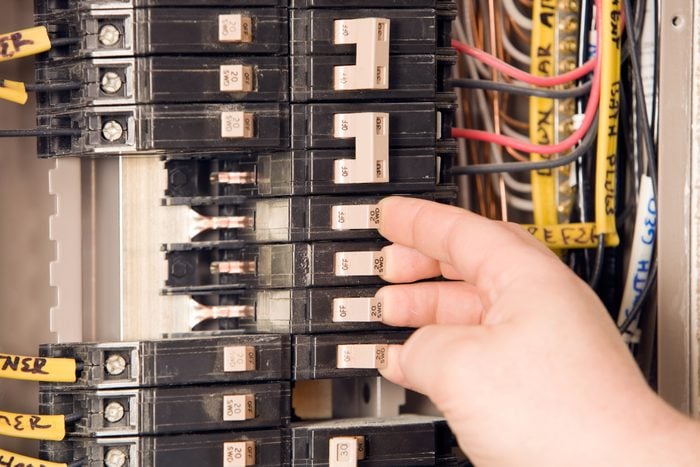
How Circuit Breakers Work
On This Page
The Problem
It’s a dark and stormy night. You flick on the hall light, plug in the coffee maker and crank up the portable electric heater. You’re starting to feel comfy, when you hear a faint, yet ominous, click—and everything goes black. It’s not a cat burglar or a poltergeist playing tricks with your electrical system. It’s an electrical circuit overload being protected by a tripped circuit breaker. Kinda spooky and mysterious, eh? Not if you know a few simple things.
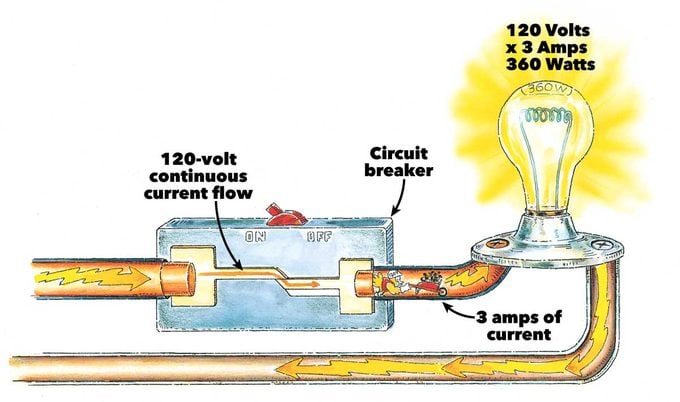
Figure A: A Properly Functioning 15-AMP Circuit
This circuit has wires and an electrical circuit breaker that can easily carry the amperage required by the devices
on it.
What’s a Circuit?
When electricity enters your home, it goes to a circuit breaker box (or fuse box in older homes), where it’s divided into a number of circuits. Each circuit is protected by a breaker or fuse. Bedrooms, living rooms and family rooms where only lights, alarm clocks and other small electrical items in your house are usually used are normally on 15-amp circuits. Kitchens, laundry rooms, bathrooms and dining rooms—places where you’re more likely to use toasters, irons, hair dryers and other big-watt items—are usually served by heavier-duty, 20-amp circuits. Major appliances like 5,000-watt electric water heaters and 10,000-watt electric ranges demand so much electricity that they take their own 30- to 50-amp dedicated circuit (See Fig. D in “Additional Information” below), protected by big, “double pole” circuit breaker sizes.
What’s a Circuit Overload?
The circuit breaker, the electrical wire and even the wire insulation are all designed to work as a system—and that system has limits. Try to push more current through a circuit than it’s designed for and things start happening (Fig. B). Wires heat up under the burden of carrying the excess current. When this happens, the insulation around the wire can degrade or even melt. When insulation melts, current is no longer confined within the wire. That’s when fires start. Luckily, the circuit breaker senses the excess current and “trips” to stop the flow of power before damage occurs.
On the night the lights went out at your house, you were fine with only the lights and coffee maker operating. The real trouble began when you plugged in that darn space heater.
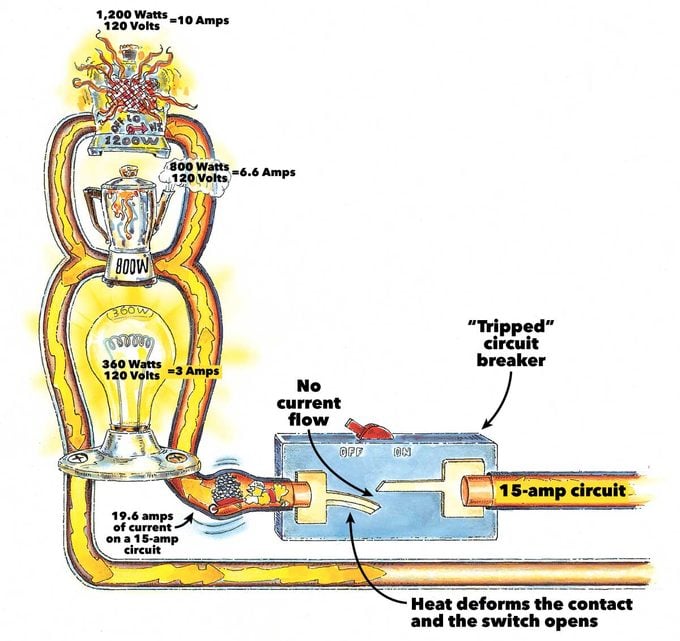
Figure B: An Overloaded Circuit
This circuit has too many energy-demanding devices on it and is trying to carry more amperage than it’s designed for. Things begin to heat up. Luckily the circuit breaker senses this, trips and “breaks” the circuit.
How to Calculate Amps, Volts and Watts
To start solving the problem, we need to know one simple “rule of thumb” formula. This formula will help us determine if all the electrical stuff on a particular circuit is overloading it. This formula also helps define some common electrical terms and how they relate to one another. After all, light bulbs and space heaters are labeled in watts; tools and circuit breakers in amps; and our household electrical system in volts: How do they all fit together?
The simple formula (Fig. C) tells us how: Watts divided by voltage equals amps. The other equations shown are just other ways of saying the same thing.
Voltage can most simply be described as the pressure under which electricity—a chain of electrons—moves. Most household current is pushed at 120 volts, though current to large electrical appliances is pushed at the higher pressure of 240 volts.
Amps (or amperes) is a measurement of the number of electrons the voltage pushes past a given point in
one second.
Watts is a unit of measurement for electrical power. It indicates how many electrons were pushed through an electric gadget to make it work. It’s what the electric company bills you for.
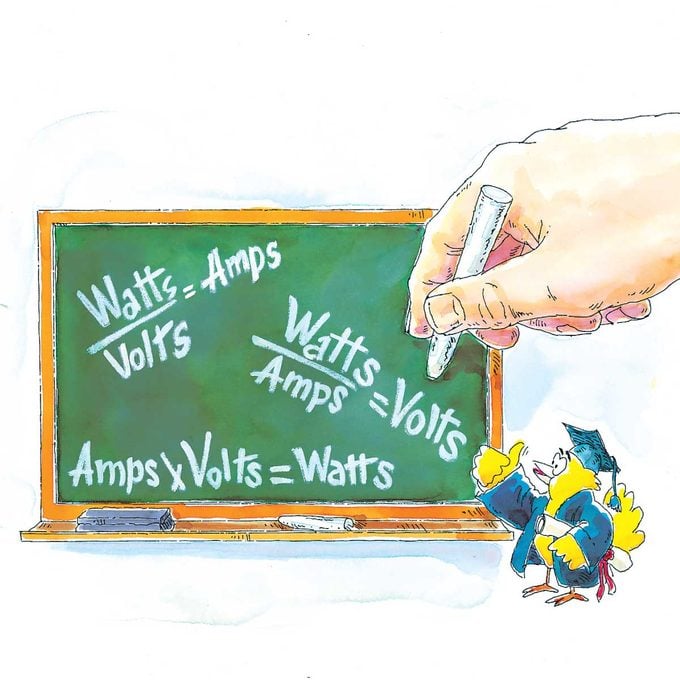
Figure C: The Basic Formula
Use these simple equations to convert different measurements of electricity to help determine things like how many outlets on a 15 amp breaker you can have or how many lights on a 15 amp circuit you can have.
Why Do Breakers Trip?
The circuit and circuit breaker that keeps tripping have a capacity of 15 amps, or 1,800 watts (15 amps x 120 volts = 1,800 watts). The lights drew 360 watts, or a measly 3 amps (360 watts divided by 120 volts = 3 amps)—well within the capacity of your 15-amp system. The 800-watt coffee maker (divided by 120 volts) drew 6.6 amps, substantially more power than the lights, but their combined 9.6-amp draw is still within the limits of the 15-amp circuit.
But when you plugged in the 1,200-watt space heater, the 10 amps it required, plus the draw of the other two devices, pulled 19.6 amps through a 15-amp system (Fig. B). It’s like a python swallowing a pig; the system just can’t handle the load. The circuit breaker tolerated this for a while. But when the excess current and resultant heat began deforming the two pieces of metal inside the breaker, they started “pulling the trigger.” And when the metal pieces bent to a certain point, the trigger snapped two contact points apart, interrupting the flow of electricity and shutting down that circuit. If there’s a huge, sudden draw on a circuit, a little electromagnet in the circuit breaker can pull the contact points apart too. If you have fuses, the excess heat melts a wire inside the fuse, which in turn stops the flow of electricity.
If this had been a 20-amp breaker—one with thicker, No. 12 wire that could carry 2,400 watts—the breaker wouldn’t have tripped. But once the wire is in the wall and the breaker is in the breaker box, there’s not much you can do to upgrade an established circuit. But you do have other choices.
240-Volt Circuits
Larger appliances, like electric water heaters, dryers and stoves, require so much power that electricity is brought to them via 240-volt circuits. That’s because the voltage in 240-volt circuits “pushes” twice as hard. For example, a 6,000-watt electric flugelhorn on a 120-volt circuit would require a 50-amp circuit (6,000 watts divided by 120 volts = 50 amps). That would require mammoth wires. But that same 6,000-watt flugelhorn on a 240-volt circuit requires only a 25-amp circuit (6,000 divided by 240 = 25) and a smaller wire and circuit breaker.
Solution One — The Short Term Fix
The simple solution is to plug the space heater into an outlet on a circuit that has excess capacity. You can determine the existing load on a circuit fairly easily: Click off the circuit breaker, then flick on light switches and test outlets to see which ones no longer function. Then add up the total watt load of devices on that circuit. This is often easier said than done. Sometimes a circuit labeled “bedroom” will power outlets in the laundry room. Or the upper and lower outlets of a duplex receptacle will be on different circuits. Once you have a circuit mapped out and the electrical loads added up, you’ll be able to tell if you can plug more devices into the circuit without overloading it.
As you add up the electrical loads, keep in mind that a wire rated at 15 amps can carry 15 amps all day long. However, 15-amp breakers and fuses can only carry 12 amps—80 percent of their rating—on a continuous basis. Continuous basis is considered to be a circuit loaded to capacity for three hours or more. This 80 percent rule applies to all breakers and fuses.
Solution Two — The Long Term Fix
The best long-term solution is to install a new dedicated circuit and outlet for the heater. Most electricians will suggest a dedicated circuit for any appliance that will draw more than half the capacity of a circuit. Fig. D in “Additional Information” (below) shows the wattage of appliances that commonly have dedicated circuits. Anytime you install a large electrical appliance—whether it’s 120 or 240 volts—install it on its own dedicated circuit with the correct size wire and circuit breaker.
As you can see from Fig. E, a 20-amp breaker with thicker, No. 12 wire can carry more current than a 15-amp circuit with No. 14 wire. When you’re wiring or rewiring a kitchen, laundry room, bathroom or dining room, the National Electrical Code will require you to install 20-amp circuits, which can carry more current. If you use a lot of power tools, it makes sense to use 20-amp circuits for your garage, workshop and basement too.
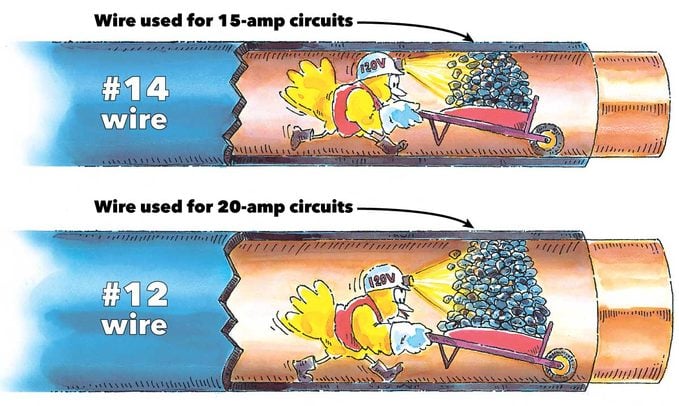
Figure E: Wire Sizes
The larger 12-gauge electrical wire can safely carry more amperage than the smaller 14-gauge wire—without overheating.
No Tampering Allowed
Homeowners who put a “penny in the fuse box” to prevent fuses from blowing have short-circuited brains. Without a fuse to disrupt the flow of power when too many amps are pushed through a circuit, wires overheat, wire insulation melts and fires break out. And you can’t simply replace a 15-amp breaker with a 20-amp breaker; that’s the modern-day equivalent of putting a penny in the fuse box. Remember, the circuit breaker, wire and wire insulation are all designed and sized to work together—safely.